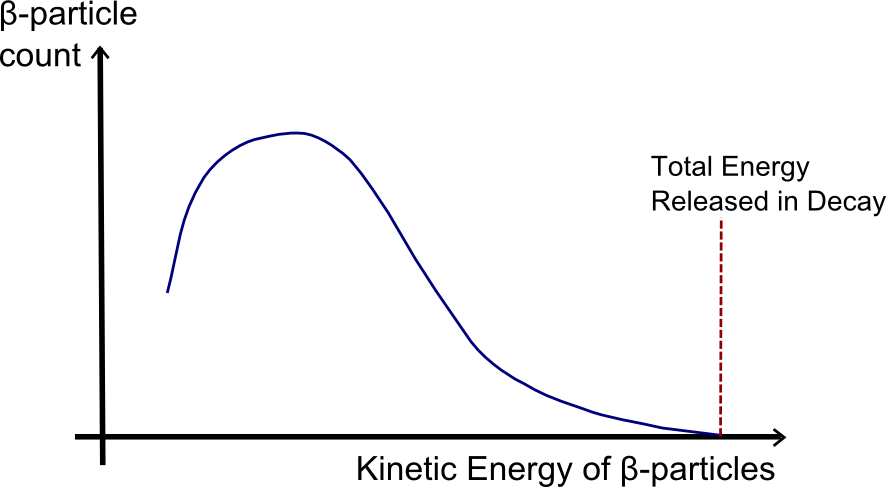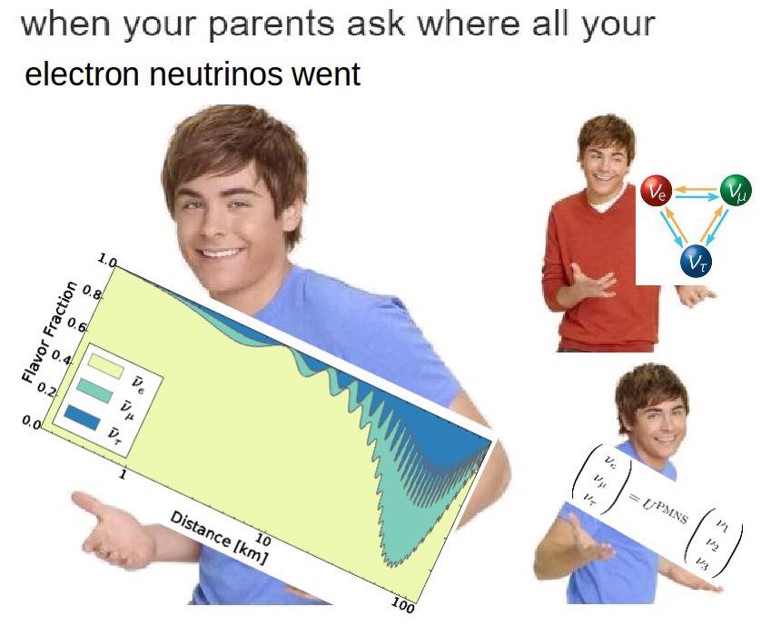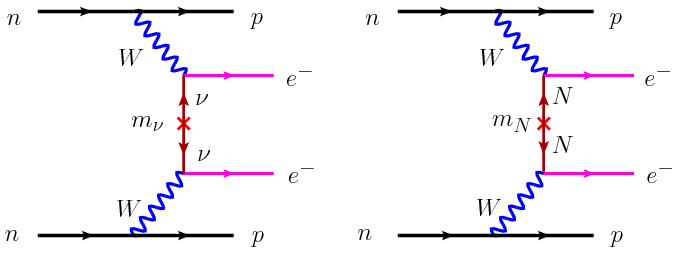Neutrino Physics
Often called the Ghost Particle, neutrinos have no electric charge and nearly no mass. Despite the fact that 100 billion of them pass through your fingernail every second, they nearly all move unimpeded and undetected through normal matter. With many mysterious and unique properties, they exist at the frontier of fundamental physics research.
 Neutrinos were first postulated in 1930 by Wolfgang Pauli to explain a problem with beta decay. Traditionally, beta decay was empirically seen as a neutron decaying into a proton and electron. As the neutron, proton and electron masses were fairly well known, the daughter products of this reaction should have had predictable energies due to the principles of conservation of momentum and conservation of energy. However, it was observed that the energy spectra was continuous - an apparant violation of the conservation of energy. Wolfgang Pauli postulated the existance of a neutrino - a small, chargeless, potentially massless particle that does not interact through the usual forces. The neutrino was eventually observed - for each of the three charged leptons (the electron, muon, and tau), there is a corresponding neutrino flavour (electron neutrino, muon neutrino, and tau neutrino).
Neutrinos were first postulated in 1930 by Wolfgang Pauli to explain a problem with beta decay. Traditionally, beta decay was empirically seen as a neutron decaying into a proton and electron. As the neutron, proton and electron masses were fairly well known, the daughter products of this reaction should have had predictable energies due to the principles of conservation of momentum and conservation of energy. However, it was observed that the energy spectra was continuous - an apparant violation of the conservation of energy. Wolfgang Pauli postulated the existance of a neutrino - a small, chargeless, potentially massless particle that does not interact through the usual forces. The neutrino was eventually observed - for each of the three charged leptons (the electron, muon, and tau), there is a corresponding neutrino flavour (electron neutrino, muon neutrino, and tau neutrino).
Particles have a "right or left handedness" known as the helicity, which relates the angular momentum ("spin") of the particle with the direction of motion. In massive particles, the helicity of the particle changes as you change reference frames - a right-handed particle will look left-handed if you travel faster than it (since the direction of the particle is reversed from your perspective). If only one handedness is observed, it means that an observer can't move faster than the particle - this implies that the particle is moving at the maximum possible speed (the speed of light), which is only possible if the particle is massless. Since only left-handed neutrinos were observed, physicists thought that the neutrino must be massless.
In the Standard Model of Particle Physics - one of the most complete, tested, and comprehensive models in all of science - the neutrino is massless.
Beyond the Standard Model
 Electron neutrinos are produced en masse in the sun. However, as early as the 1960s, physicists began to notice a discrepancy in these solar neutrinos - signficiantly fewer solar electron neutrinos were produced than expected. This "Solar Neutrino Problem" was a signficant outstanding issue in the Standard Model, which was thought to otherwise be complete and well-understood. It turns out that the neutrinos can oscillate between flavours. This can only happen if the three neutrinos have three different masses - in this case, the "flavours" are just different mixed versions of the three neutrino masses. Takaaki Kajita of the Super-Kamiokande experiment and Art Mcdonald of the SNO experiment was awarded the 2015 Nobel Prize for this discovery.
Electron neutrinos are produced en masse in the sun. However, as early as the 1960s, physicists began to notice a discrepancy in these solar neutrinos - signficiantly fewer solar electron neutrinos were produced than expected. This "Solar Neutrino Problem" was a signficant outstanding issue in the Standard Model, which was thought to otherwise be complete and well-understood. It turns out that the neutrinos can oscillate between flavours. This can only happen if the three neutrinos have three different masses - in this case, the "flavours" are just different mixed versions of the three neutrino masses. Takaaki Kajita of the Super-Kamiokande experiment and Art Mcdonald of the SNO experiment was awarded the 2015 Nobel Prize for this discovery.
Since the Standard Model predicts all neutrions to have no mass, this discovery proved that the Standard Model is incomplete. As the first experimentally observed physics beyond the standard model, neutrinos are the vanguard of a new era of particle physics.
Majorana Neutrinos
One important possible consequence of massive neutrinos is the existance of Majorana particles. Fermions such as the electron are very well understood to be described by the Dirac equation. In the 1930s, Italian theorist Ettore Majorana proved that massive fermions with no charge could be described by a simplification to the Dirac equation. In this "Majorana particle" paradigm, the fermion and corresponding anti-fermion would be the same particle! As the only known massive chargeless particle, the neutrino is the only Majorana particle candidate. If neutrinos are Majorana particles, this would have many significant implications to our understanding of physics and the universe.One such implication of Majorana particles is leptogenesis - the observed matter and antimatter asymmetry in the universe. Matter and antimatter is produced in equal quantities in the universe, and they annihilate each other when interacting. However, we're made of matter - if matter and antimatter is created and destroyed in equal quantities, how can we exist? How come there is so much more matter than antimatter? The existance of Majorana particles can answer fundamental questions about humanity such as leptogensis, as well as many more from grand unified theories to the neutrino hierarchy problem.
Neutrinoless Double Beta Decay
 The most practical way to investigate the Majorana nature of neutrinos is through a special radioactive decay known as double beta decay. In double beta decay, 2 neutrons simultaneously decays into 2 protons, releasing 2 electrons and 2 electron antineutrinos in the process. This "two neutrino double beta decay" (2vbb) is a Standard Model process and already observed in 33 different elemental isotopes. However, if neutrinos and antineutrinos are the same particle, the two released neutrinos can occasionally interact and annihilate with each other! In this case, only 2 electrons would be released, and the decay is known as "neutrinoless double beta decay" (0vbb). Since there is no neutrino to carry away any energy, the summed energies of the two electrons should equal the well-known total energy released in the decay.
The most practical way to investigate the Majorana nature of neutrinos is through a special radioactive decay known as double beta decay. In double beta decay, 2 neutrons simultaneously decays into 2 protons, releasing 2 electrons and 2 electron antineutrinos in the process. This "two neutrino double beta decay" (2vbb) is a Standard Model process and already observed in 33 different elemental isotopes. However, if neutrinos and antineutrinos are the same particle, the two released neutrinos can occasionally interact and annihilate with each other! In this case, only 2 electrons would be released, and the decay is known as "neutrinoless double beta decay" (0vbb). Since there is no neutrino to carry away any energy, the summed energies of the two electrons should equal the well-known total energy released in the decay.
0vbb experiments attempt to observe 0vbb by detecting and summing up the energies of the two released electrons. The summed energy of the two electrons normally have a continuous energy spectrum (since some energy is carried away by the neutrinos) due to the 2vbb decay. However, if neutrinos are indeed majorana, there is also a rare chance for the summed energy of the electrons to equal the total energy loss in the decay (known as the Q-value). It is this small monoenergtic peak that 0vbb experimentalists are looking for. Previous page: Research Interests
Next page: The SNO+ Experiment